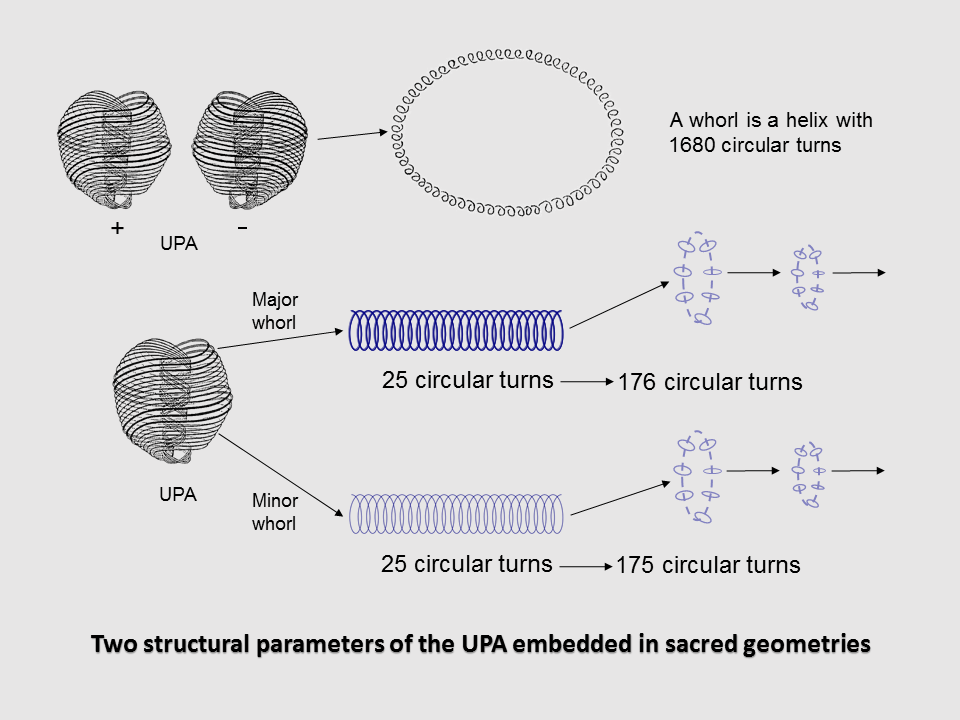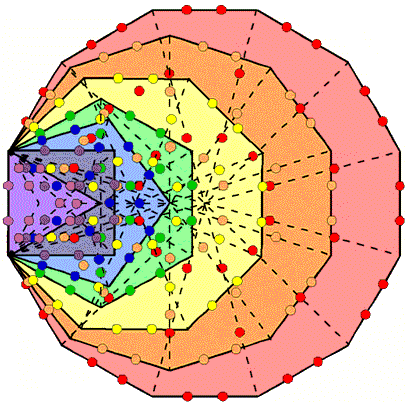

| << Previous 1... 6 7 8 9 [10] Next >> |
The 3-d Sri Yantra embodies the augmentation numbers 175 & 176 for the major and minor whorls of the UPA
 |
 |
According to C.W. Leadbeater, every section of 100 spirillae of the nth order in a major whorl is composed of 704 spirillae of the (n+1)th-order, whereas for each minor whorl there are 700 such spirillae. This means that one extra spirilla of the (n+1)th-order is added on average for every 25 nth-order spirillae in a major whorl, so that they comprise 176, not 175, spirillae of the next lower order. The presence of extra spirilla in every one of the seven orders of spirillae of the major whorls explains why they appear thicker that the minor whorls.
When the 42 triangles in the 3-dimensional Sri Yantra that surround its central triangle are tetractyses, 168 yods line the 63 sides of the 21 tetractyses in each half (see #3). A Type A triangle contains 19 yods. Three of these are hexagonal yods at the centres of its three tetractyses and 16 yods line their six sides. The black yod at the centre of the central triangle and the black yod at its lowest corner are the only corners of these three tetractyses that are not shared with the 42 triangles surrounding it when the four sheets of triangles merge into the single one of the 2-dimensional Sri Yantra. The 16 boundary yods in the central triangle comprise two sets of eight yods. One black yod and seven red or blue yods can be associated with each set of 168 yods. Hence, (the 336+16=352) yods lining the 132 sides of the 45 tetractyses consist of 176 yods associated with each vertical half of the 3-dimensional Sri Yantra. Each set of 176 yods comprises one black yod and 175 red or blue yods. The Sri Yantra embodies not only the structural parameter 168 of the UPA but also the number determining the augmentation of its major whorls. The two black yods play the role of the endpoints of the root edge separating the two sets of seven enfolded polygons making up the inner form of the Tree of Life. They are the beginning and the end of its geometrical construction. Amazingly, 176 hexagonal yods line the 47 sectors of each set of seven polygons when they become tetractyses:

One hexagonal yod in the root edge corresponds to one black yod and one hexagonal yod in the separate mirror image of the seven enfolded polygons corresponds to the other black yod, which belongs to the other half of the Sri Yantra.
The number of yods lining the 45 tetractyses in the 3-dimensional Sri Yantra that surround its centre is 351, where
351 = 1 + 2 + 3 + ... + 26
is the 26th triangular number and the number value of Ashim, the Order of Angels assigned to Malkuth. This shows how YAHWEH, the Godname of Chokmah with number value 26, prescribes the shape of the 3-dimensional Sri Yantra constructed from tetractyses. As
351 = 15 + 336,
we see that the superstring structural parameter 336 is the sum of the first 26 integers minus the 15th integer. 15 is the number of YAH, which is the older form of the complete Godname YAHWEH. As
15 = 1 + 2 + 3 + 4 + 5,
336 is the sum of the (26−5=21) consecutive integers 6-26:
6 + 7 + 8 + ... + 26 = 336.
This is how EHYEH, the Godname of Kether with number value 21, arithmetically prescribes the superstring structural parameter 336 (the number of turns in each of the five revolutions of a whorl of the UPA around its axis of spin). 15 yods line the three tetractyses in the central triangle. Therefore, the arithmetic identity:
351 = 15 + 336
manifests in the geometry of the 3-d Sri Yantra as the 15 boundary yods in the central triangle and the 336 boundary yods in the 42 triangles that surround it. The very number that expresses the shape of the 42 triangles in the Sri Yantra generates the oscillatory form of each whorl in the UPA.
| << Previous 1... 6 7 8 9 [10] Next >> |